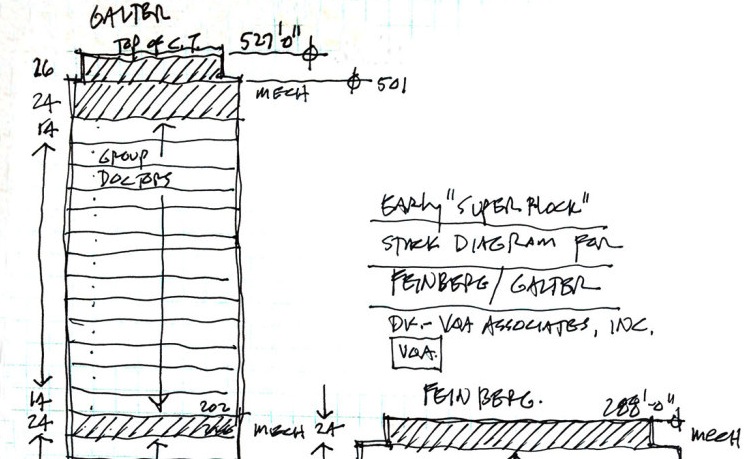Tall buildings excite us. The quest to build increasingly taller structures came soon after humans constructed our first shelters and hasn’t let up since. While these early megaliths frequently celebrated religion and spirituality, more recent tall structures take the form of office buildings, hotels and living environments. Can skyscrapers be healthcare environments, too?
Here at VOA, we’re especially interested in the future of vertical healthcare environments. We have designed several of the tallest healthcare structures in the world (buildings such as Prentice Women’s Hospital and Feinberg/Galter Pavilion at Northwestern Memorial Hospital in Chicago), and pioneered the vertical campus with the Wabash Building on the Roosevelt University Campus. In this series of blog posts, informed by this experience, I will address the challenges and opportunities associated with creating and constructing tall healthcare environments.
Why tall healthcare environments and why now?
The growth in vertical healthcare environments coincides with trends in healthcare and advances in the design industry. Today, vertical healthcare environments number less than few dozen worldwide, but these trends suggest a likely increase in healthcare in buildings constructed to be 300 feet and taller.
The primary drivers of this trend to tall healthcare environments are:
- Improvements in high speed elevator technology and quality of the elevator ride
- Increase in outpatient treatment leading to the need to co-locate the inpatient and the outpatient functions in proximity
- Perceived efficiency by hospital staff in locating private doctor’s offices, exam areas and the inpatient environment in a single structure
- The desire to mitigate rising real estate costs for healthcare institutions located in urban centers
The Design Challenge
The creation of vertical healthcare environments requires harnessing a variety of complex technologies. High-rise structures introduce a myriad of design challenges in terms of structural engineering, HVAC (heating, ventilation and air conditioning), vertical transportation, way-finding, and aesthetics–making these building types a specialty. Add the healthcare component to a high-rise and you’ve got a further layer of complexity with its own unique set of challenges. Our blog series will address these challenges from the perspective of the healthcare planning and design experts at VOA with invited input by guest colleagues and consultants.

The Stack
To understand vertical healthcare environments, start with The Stack, a fascinating diagram made during the design of vertically-oriented buildings. A stacking diagram of the proposed healthcare building describes the vertical distribution of functions in the facility as an infographic. Here, we featured a rendition of the early stack diagram done for one of the tallest healthcare structures in the world, the Feinberg/Galter Pavilion at Northwestern Memorial Hospital.
The the stack for a vertical healthcare environment raises many questions and design challenges: What is the impact on master planning the medical center? How are way-finding and pedestrian flow addressed for visitors and patients? What HVAC strategies are available? How do regulatory requirements impact the design for these structures? Is a sustainable healthcare environment achievable in a vertical healthcare environment? What type of façade design is possible for a vertical healthcare environment?
This series will investigate these questions and many more.
About the Author: Douglas J. King, AIA, NCARB, CSI, ACHA, is an instrumental leader in VOA’s Healthcare practice, with a particular emphasis on VOA Federal Healthcare. He is an active and visible voice in his industry, with presentations that span the globe and articles published in Facility Care Magazine and Matrix Magazine, among other publications. More on King.
More from Author
Stantec | Jul 18, 2024
Why decarbonizing hospitals smartly is better than electrification for healthcare design
Driven by new laws, regulations, tariffs, ESG goals, and thought leaders in the industry itself, healthcare institutions are embracing decarbonization to meet 2050 goals for emissions reductions.
Stantec | Jun 18, 2024
Could ‘smart’ building facades heat and cool buildings?
A promising research project looks at the possibilities for thermoelectric systems to thermally condition buildings, writes Mahsa Farid Mohajer, Sustainable Building Analyst with Stantec.
Stantec | Jun 8, 2024
8 ways to cool a factory
Whichever way you look at it—from a workplace wellness point of view or from a competing for talent angle—there are good reasons to explore options for climate control in the factory workplace.
Stantec | Apr 18, 2024
The next destination: Passive design airports
Today, we can design airports that are climate resilient, durable, long-lasting, and healthy for occupants—we can design airports using Passive House standards.
Stantec | Mar 18, 2024
A modular construction solution to the mental healthcare crisis
Maria Ionescu, Senior Medical Planner, Stantec, shares a tested solution for the overburdened emergency department: Modular hub-and-spoke design.
Stantec | Nov 20, 2023
8 strategies for multifamily passive house design projects
Stantec's Brett Lambert, Principal of Architecture and Passive House Certified Consultant, uses the Northland Newton Development project to guide designers with eight tips for designing multifamily passive house projects.
Stantec | Apr 10, 2023
Implementing human-centric design in operations and maintenance facilities
Stantec's Ryan Odell suggests using the human experience to advance OMSF design that puts a focus on wellness and efficiency.
Stantec | Jul 6, 2022
5 approaches to a net zero strategy that communities can start right now
Whether your community has started on a plan or is still considering net zero, now is the time for all of us to start seriously addressing climate change.
Stantec | Feb 14, 2022
5 steps to remake suburbs into green communities where people want to live, work, and play
Stantec's John Bachmann offers proven tactic for retrofitting communities for success in the post-COVID era.
Stantec | Feb 8, 2022
How gaming technology is changing the way we design for acoustics
Adding 3D sound from gaming engines to VR allows designers to represent accurate acoustic conditions to clients during design.
















